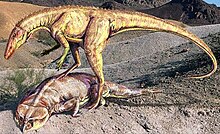Staurikosaurus
| Staurikosaurus Temporal range: Late Triassic-Early Jurassic,
| |
|---|---|

| |
| Reconstructed skeleton | |
| Scientific classification | |
| Domain: | Eukaryota |
| Kingdom: | Animalia |
| Phylum: | Chordata |
| Clade: | Dinosauria |
| Clade: | Saurischia |
| Clade: | Theropoda |
| Family: | †Herrerasauridae |
| Genus: | †Staurikosaurus Colbert, 1970 |
| Species: | †S. pricei
|
| Binomial name | |
| †Staurikosaurus pricei Colbert, 1970
| |
Staurikosaurus ("Southern Cross lizard") is a genus of herrerasaurid[1] dinosaur from the Late Triassic of Brazil.
Discovery



The first known specimen of Staurikosaurus was recovered from the Paleontological Site Jazigo Cinco of the Santa Maria Formation[2] in the geopark of paleorrota, Rio Grande do Sul, southern Brazil. The genus name refers to the star constellation "The Southern Cross", pictured in the coat of arms of Brazil and only visible in the southern hemisphere - when Staurikosaurus was described in 1970, it was unusual to find dinosaurs in the southern hemisphere. The specific name honours the Brazilian paleontologist Llewellyn Ivor Price, who discovered it in 1936. It was described by Edwin Harris Colbert, working at the American Museum of Natural History. The rarity of Staurikosaurus remains may be a result of it being uncommon while alive, or because it lived in an environment like a forest, where fossils rarely form.[2]
Description


Staurikosaurus was a small theropod from the late Triassic Period, 225 million years ago - specifically the Carnian age. It is one of the earliest dinosaurs that is known. At just 2.25 metres (7.4 ft) long,[3] 80 centimetres tall (31 in), and weighing just 30 kilograms (66 lb), Staurikosaurus was tiny in comparison to later theropods like Megalosaurus. Newer research seems to confirm that Staurikosaurus and the related Herrerasaurus are definite theropods and evolved after the sauropod line had split from the Theropoda.
There exists very incomplete fossil record of Staurikosaurus, consisting most of the spine, the legs and the large lower jaw. However, dating from such an early period in the dinosaurs' history and being otherwise so primitive, most of Staurikosaurus' other features as being primitive also can be reconstructed. For example, Staurikosaurus is usually depicted with five toes and five fingers[2] - very simple features of an unspecialised dinosaur. However, since the skeletal structure of the legs is known, it can be seen that Staurikosaurus was a quick runner for its size. It also had just two vertebrae joining the pelvis to the spine, a distinctly primitive arrangement.
Flag of Paleorrota Geopark

The flag of the Paleorrota Geopark, is the flag of Rio Grande do Sul with white Staurikosaurus in the center. It is a tribute to Brazilian first dinosaur found by Llewellyn Ivor Price, in Santa Maria City.
See also
Contemporaries
References
- ^ Nesbitt, S. J., Smith, N. D., Irmis, R. B., Turner, A. H., Downs, A., and M. A. Norell. 2009. A complete skeleton of a Late Triassic saurischian and the early evolution of dinosaurs. Science 326:1530-1533.
- ^ a b c "Staurikosaurus." In: Dodson, Peter & Britt, Brooks & Carpenter, Kenneth & Forster, Catherine A. & Gillette, David D. & Norell, Mark A. & Olshevsky, George & Parrish, J. Michael & Weishampel, David B. The Age of Dinosaurs. Publications International, LTD. p. 45. ISBN 0-7853-0443-6.
- ^ Grillo, O.N. and Azevedo, S.A.K. (2011). "Recovering missing data: estimating position and size of caudal vertebrae in Staurikosaurus pricei Colbert, 1970." Annals of the Brazilian Academy of Sciences,
